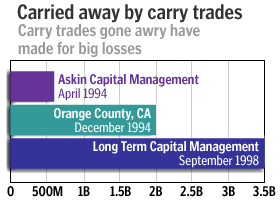NEW YORK (CNN/Money) - The chatter about a return to the glory days from some corners of Wall Street may be helping succor Wall Street's bulls. For some banks, it could be a nightmare.
The rapid fall of the Iraqi regime, and suggestions that there was a pickup in business during the past week, are helping fuel optimism that the economy may finally pull out of the doldrums. Some market players foresee an environment where the conservatism that's infected the stock market and the economy over the past three years may be rapidly reversed.
In particular, the large reserves of cash built up since early 2000 have the bulls salivating like Pavlov's dog. There's $1 trillion in retail money market funds now, up from around $800 billion in early 2000, according to the Investment Company Institute. In the same period, Federal Reserve data show that savings deposits have jumped by more than $1 trillion to $2.9 trillion. Imagine what might happen if this money is put back to work through stocks, investments in new businesses and big-ticket purchases consumers have put off through the tough times. The economy would be in a virtuous cycle, where growth begets growth and life would be sweet again.
Good for the economy, but is it good for the bank?
But this bullish scenario might have unwanted side effects at banks and other financial institutions that have taken the funds flowing into low-yielding savings and money market accounts and invested them in higher yielding, and riskier, assets in a bid to generate returns and goose income. In particular, the banks appear to have pushed cash into the tradable baskets of mortgage loans known as mortgage-backed securities. This is a particularly lucrative play in the current environment, because the yield curve -- the difference between short-term rates that determine what they pay depositors in interest and the longer-term rates that mortgage-backed securities throw off -- is so steep.

"The whole game now is just playing the yield curve," said CreditSights bank credit analyst David Hendler.
As an example, FleetBoston said on its first-quarter conference call Monday that it had added $4 billion-to-$4.5 billion of residential mortgage securities to its securities portfolio since the end of the fourth quarter, and also said that it was largely thanks to this move that it was able to maintain its growth margin. Hendler estimates that the yields these mortgage-backed securities threw off were good for 4 cents of the 55 cents per share from continuing operations Fleet earned in the first quarter.
The problem with such carry trades is that when they go wrong, the results can be horrible. The most severe example was in 1998, when the highly leveraged hedge fund Long Term Capital Management was financing its high-yielding emerging debt purchases by borrowing (shorting) low-yielding Japanese debt. Great strategy, until Russian debt went into default, forcing the fund to unwind positions rapidly and setting off what became known as the Long Term Capital Management crisis.
The International Monetary Fund worries that a similar, although hopefully not as severe, problem could develop with the carry trades banks have been putting on if the economy suddenly finds its footing again. The scenario, where investors decide en masse that cash isn't king anymore, is also a scenario where an improving economy would prompt the Federal Open Market Committee to move the fed funds target rate up from its current 40-year low of 1.25 percent. Higher rates would push the prices of Treasury bonds and mortgage-backed issues -- the assets that yield-hungry banks are putting their pennies into -- lower. It could put banks into a position where they would all rush to unwind their carry trades at the same time.
"In this view," wrote the IMF in a recent report, "an unanticipated increase in interest rates could provoke a dumping of positions with potentially destabilizing effects."
Risk not without precedent
Maybe such concerns are overblown. Nobody expects the Fed to raise rates any time soon; on the contrary, most economists on Wall Street think that, if anything, the Fed is more likely to lower the funds rate in the months to come.
But the Fed has long indicated that it considers current rates unnaturally low, and there's a sense that, given signs that the economy had turned the corner, it would be eager to raise rates. Moreover, in the minutes to its January meeting, the Federal Open Market Committee said that it "could envision circumstances when it might find it desirable to adjust its policy stance substantially and promptly in one direction or the other in the months ahead."
Nor would it be the first time an improving economy and higher rates caught banks asleep at the switch. Carry trades were the rage a decade ago, when the Fed funds rate spent the latter half of 1992 and all of 1993 at 3 percent. In 1994 the Fed began tightening and by the beginning of 1995 the funds rate was up to 6 percent. It was bad news for the carry traders, many of whom were highly leveraged and using derivative instruments whose risks they didn't understand. Hedge funds that were playing the game took steep losses -- one, Askin Capital Management, was forced to fold. Banks like Mellon and PNC saw hits to their bottom lines. Orange County, Calif., went bankrupt.
"Everyone was reaching for yield," said Brian Reynolds, fixed income and economic strategist at Kirlin Securities. "When the Fed first tightened, people were surprised as heck."

|

